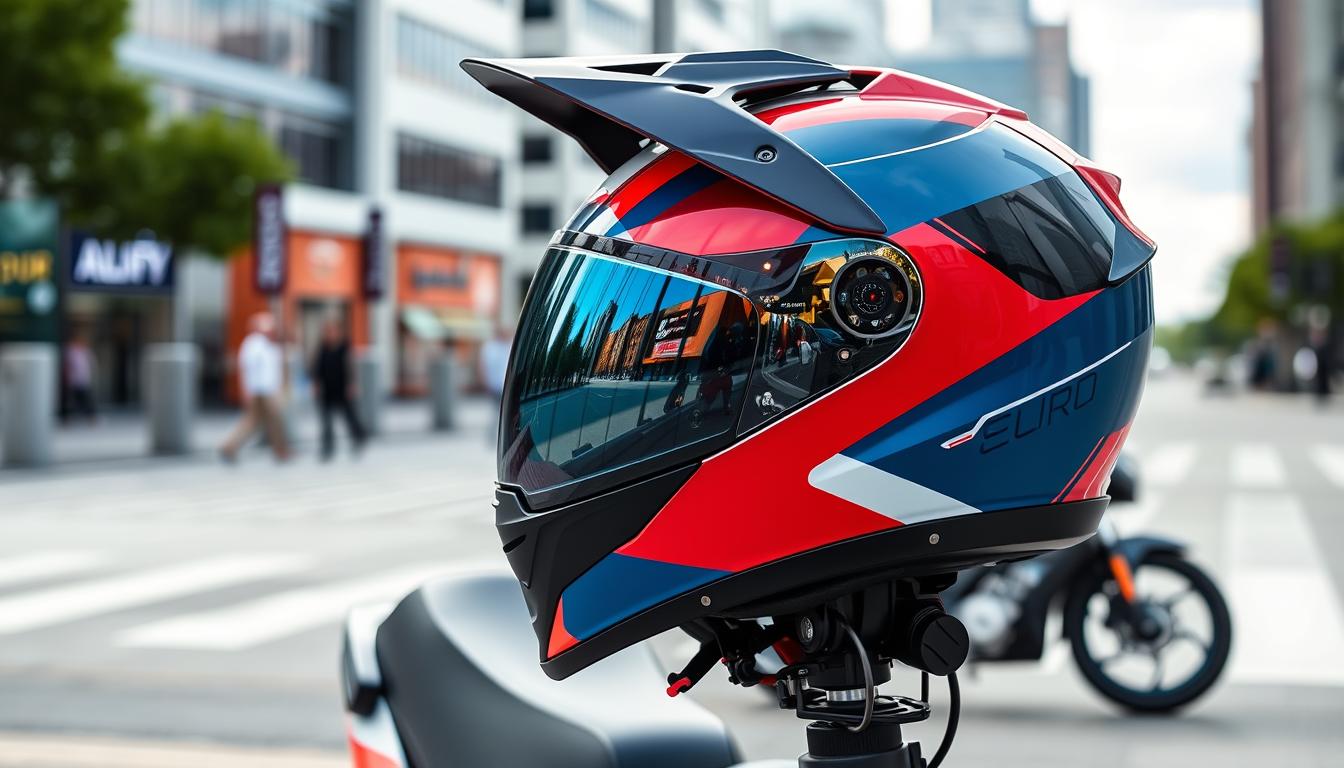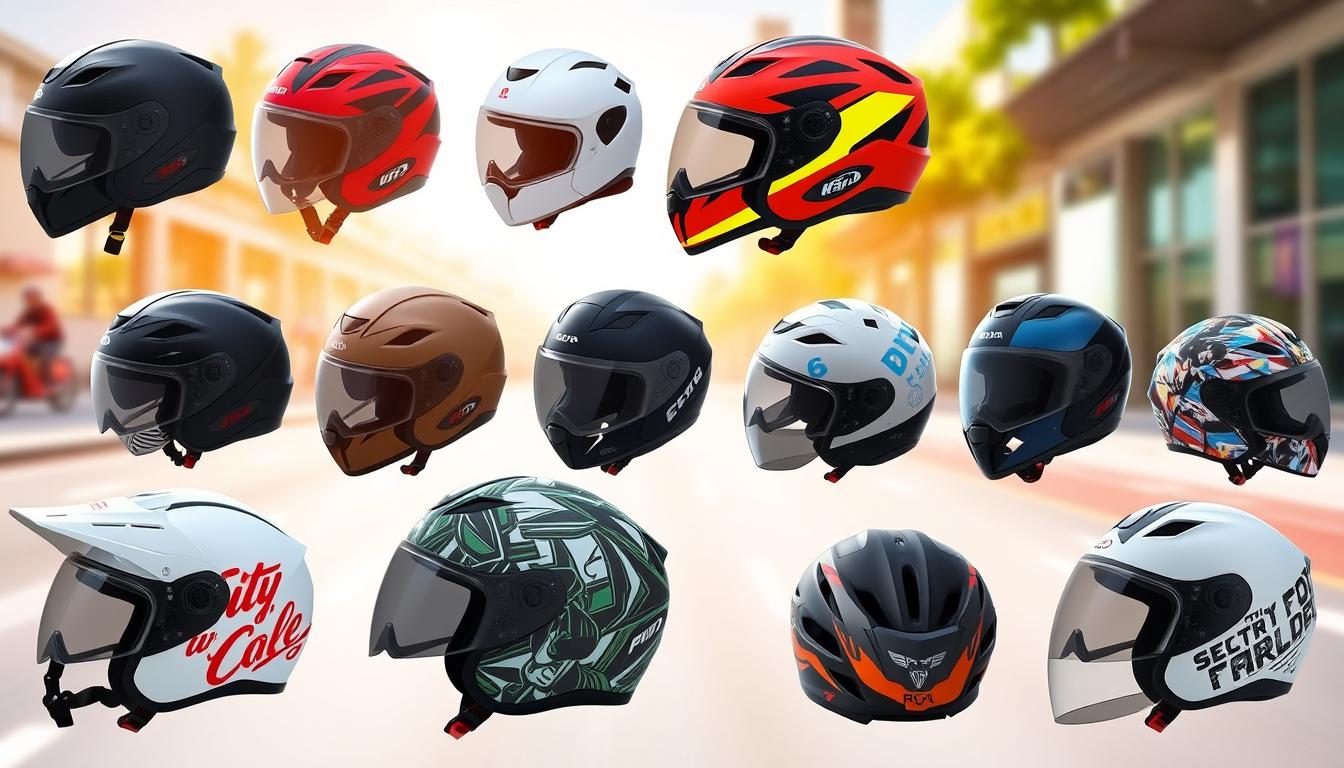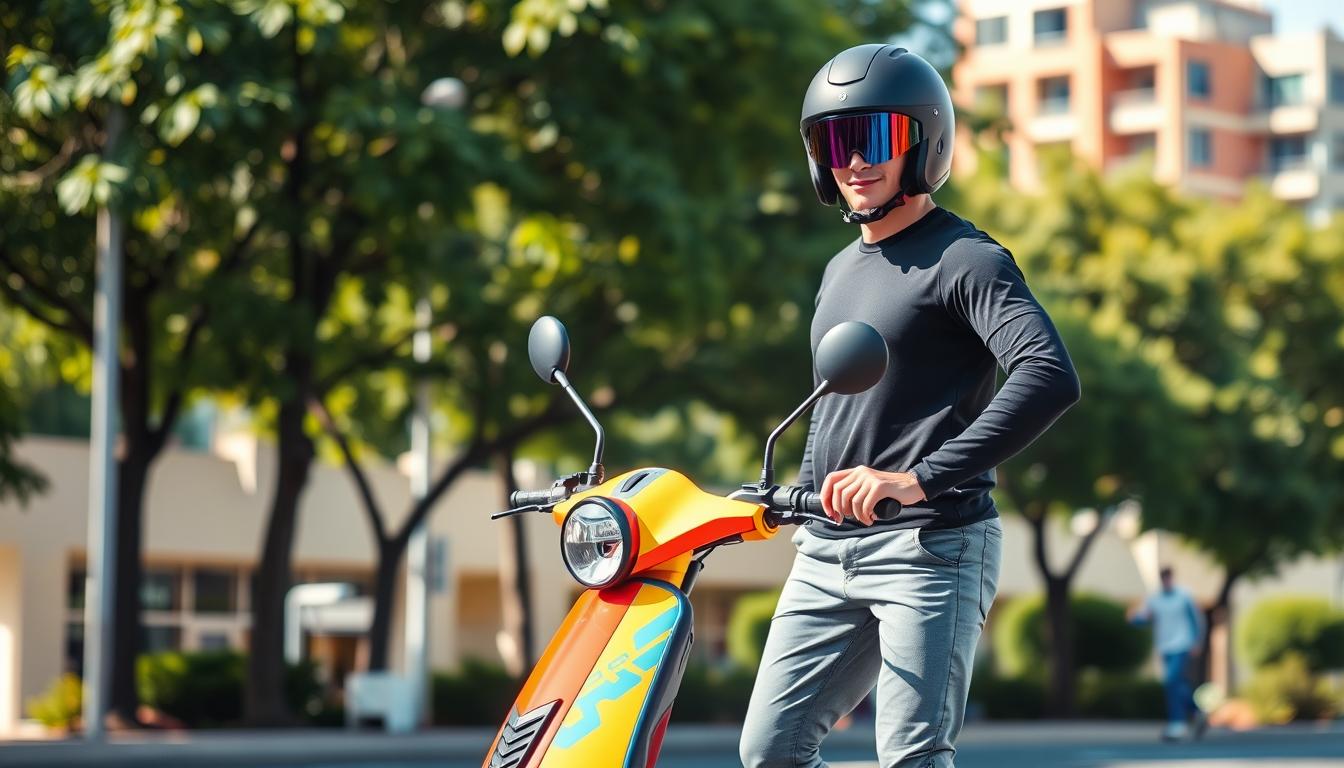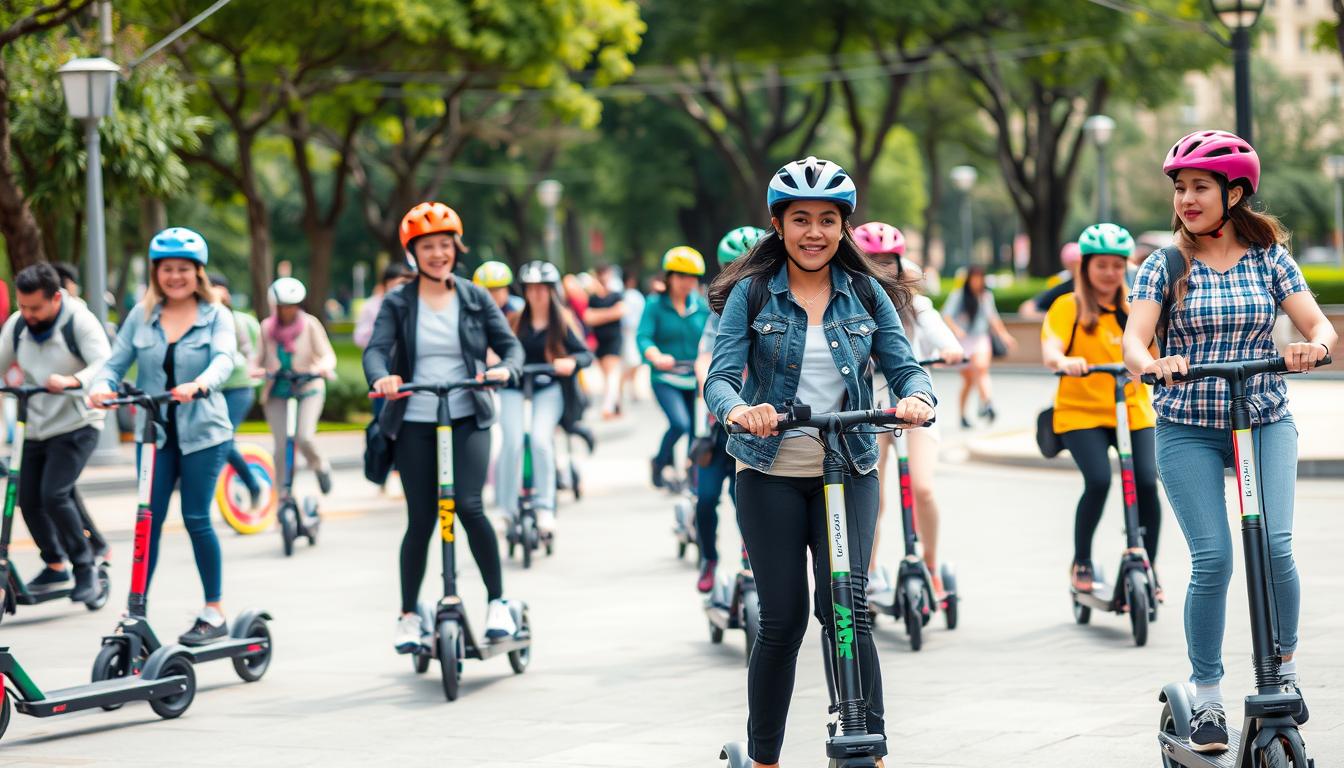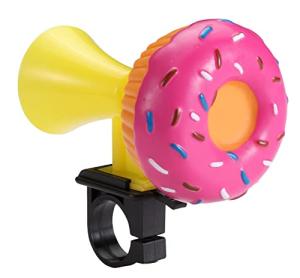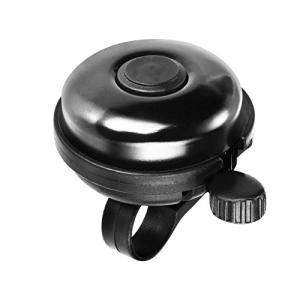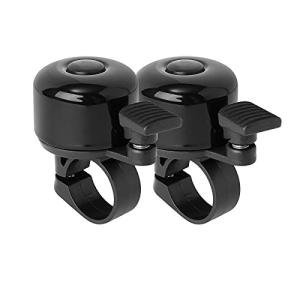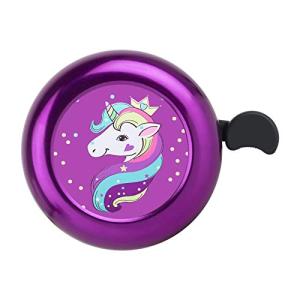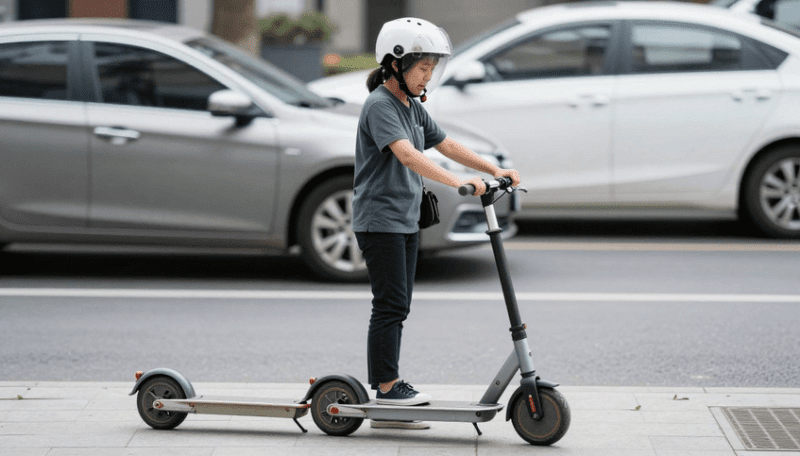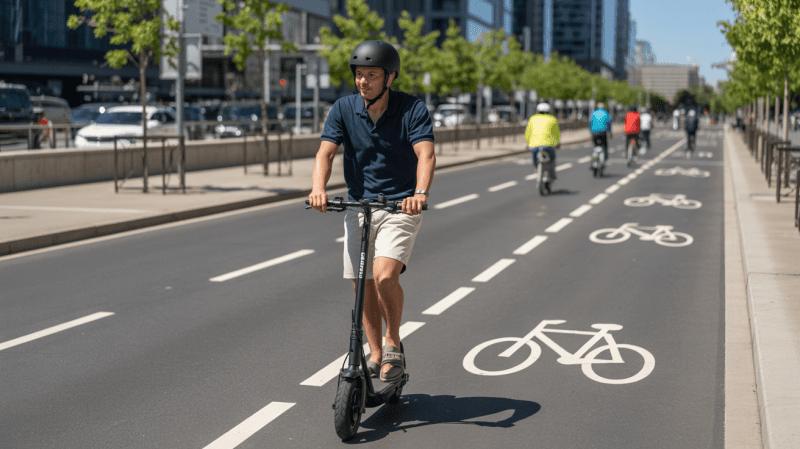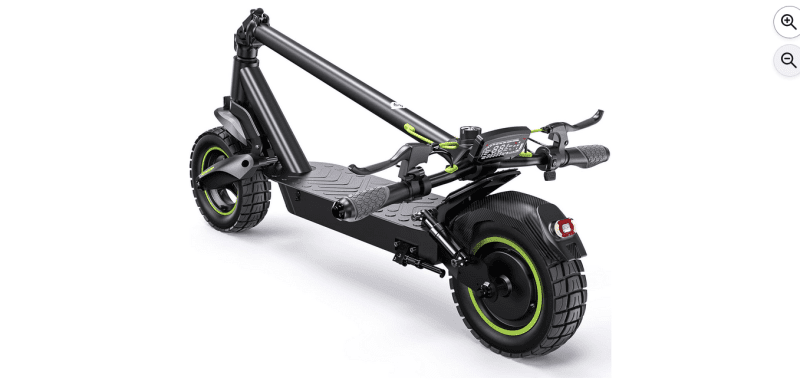Scooters are getting more popular for getting around and having fun. They can travel quickly and are often used on rough terrain. This makes them more likely to crash, which can hurt your head badly.
Studies show that most riders don't wear helmets, and a lot of injuries are to the head. But, wearing a helmet can really help. It can lower your risk of brain injury by 52% and death by 44%.
Key Takeaways
- Wearing a safety helmet can significantly reduce the risk of head injuries in scooter accidents.
- Head trauma is the most common and potentially life-threatening injury in scooter-related accidents.
- Helmets have been shown to prevent up to 85% of head injuries in bicycle accidents, and the same principles apply to stand up scooters.
- Proper helmet use is often mandated by law, and non-compliance can result in penalties.
- Choosing the right helmet with the appropriate safety certifications is crucial for your protection.
Understanding the Risks of Riding Without Head Protection
Riding stand-up scooters without a helmet is very dangerous. Scooter accidents often cause head injuries. These injuries can be very serious and last a long time.
Even a small head hit can lead to a traumatic brain injury (TBI). This can change a person's life for months or years.
Common Head Injuries from Scooter Accidents
Head injuries are the most common in electric scooter accidents. They can be mild or very serious. Fractured skulls, brain bleeds, and permanent damage are possible without a helmet.
Statistics on Scooter-Related Head Trauma
- Over 50,000 skateboarders are sent to the hospital with injuries every year.
- In 2007, almost 12,000 kids under 14 were treated for head injuries from skateboarding.
- More than 1,200 people die in bicycle, roller blade, scooter, and skateboard accidents each year.
- 1 in 3 people in electric scooter accidents need emergency room treatment.
- Only 4% of riders in a study wore helmets.
- Head injuries made up 40% of scooter crash injuries.
Impact of Head Injuries on Daily Life
Head injuries can change a person's life a lot. They can cause memory loss, trouble with senses and movement, and even change a person's personality. These problems can make it difficult to work, maintain relationships, and perform daily tasks.
This shows why wearing a helmet is so important. It helps avoid brain injuries and keeps you safe.
"Helmets can reduce the risk of head injuries by at least 45% according to the Children's Hospital Los Angeles."
The Importance of Wearing a Safety Helmet When Riding a Stand Up Scooter
Riding a stand-up scooter is popular and convenient. But, it also has risks. We must always wear a safety helmet to stay safe.
Wearing a helmet is key to avoiding head injuries. These injuries can be very serious. Helmets help reduce the risk of brain injuries and death in falls or crashes.
Children and teens are more likely to fall or crash. They are still learning how to ride. So, they need to wear helmets.
- Between January 2019 and June 2022, 804 people visited the regional trauma center due to scooter accidents. The sample consisted of 66.2% males and 33.8% females.
- In the pediatric group, 3.7% of patients wore helmets. Those who did had fewer major trauma cases than those without helmets.
- Among adults, only 3.7% wore helmets. Yet, they had fewer major trauma cases than those without helmets.
Wearing a safety helmet keeps us safe and sets a good example. It shows others, especially kids, the importance of safety. This encourages more people to use eco-friendly transport with the right personal protective equipment.
"Helmets for children or toddlers should have a buckle that holds firm in a crash but releases after five seconds of steady pull to avoid potential strangulation."
In summary, wearing a safety helmet is crucial when riding a stand-up scooter. It keeps us safe, shows others the right way, and helps the whole micromobility community. By wearing helmets, we can enjoy riding while staying safe and inspiring others to do the same.
Legal Requirements and Regulations for Scooter Helmets
The rules about electric scooters and helmets can be confusing. Around the world and in the U.S., the laws and fines for not wearing a helmet differ a lot. It's important for scooter fans to know the local laws to stay safe and follow the rules.
International Helmet Laws
In places like Norway, Denmark, and Spain, all scooter riders must wear helmets. But in France and the UK, it's not required. Always check the helmet laws in any area before you ride.
State-Specific Requirements
In the U.S., the helmet laws for scooters vary by state. Most states require children under 18 to wear helmets. But some states, like California and Arkansas, require all riders to wear helmets. Florida is one state where there's no statewide helmet law, but cities might have their own rules.
Penalties for Non-Compliance
Not wearing a helmet can result in significant fines or even having your scooter confiscated. In some places, you could even face criminal charges. Not following helmet laws is dangerous and can also result in significant financial and legal consequences.
Understanding scooter laws and helmet rules might seem hard, but it's key to being a safe rider. By knowing the rules and focusing on safety, we can have fun riding scooters while keeping everyone safe on the roads.
Different Types of Safety Helmets for Scooter Riders
There are many safety helmets for electric scooter riders. You can choose from folding helmets for easy carry to full-face motorcycle helmets for top protection. The best helmet depends on how fast you ride, where you ride, and how often.
Skateboard-style helmets are popular. They have an ABS plastic shell for safety and are well-ventilated for comfort. Bike helmets are also great, with adjustable visors to block the sun and wind.
Mountain bike and BMX helmets offer extra face protection. They have a strong chin guard and cover more of your head. Full-face motorcycle helmets protect your whole head and face but can be heavier and less breathable.
| Helmet Type | Key Features | Ideal for | Price Range |
|---|---|---|---|
| Folding Helmet | Compact, collapsible design for easy storage and portability | Commuters, urban riders | $90 - $120 |
| Skateboard Helmet | ABS plastic shell, good impact protection, well-ventilated | Casual urban riding, skateparks | $40 - $80 |
| Bike Helmet | Adjustable visor, lightweight, comfortable for long rides | Recreational riders, commuters | $50 - $100 |
| Mountain Bike/BMX Helmet | Reinforced chin guard, extended coverage for temples and back of head | Off-road, high-speed riding | $80 - $150 |
| Full-Face Motorcycle Helmet | Encloses the entire head and face, maximum protection | High-speed, long-distance riding | $150 - $300 |
It's important to pick a helmet that meets safety standards like CPSC certification. This ensures it protects you well in case of an accident. With the right helmet, you can enjoy riding your electric scooter safely.
Essential Features to Look for in a Scooter Helmet
The helmet is key for stand-up scooter riders. It's the most important gear for safety. The right helmet can save you from serious accidents. Let's look at what makes a helmet safe and comfortable for scooter riding.
Safety Certifications and Standards
First, check the safety certifications and standards of the helmet. Laws in many places require the use of helmets for electric scooters. Look for helmets that meet CPSC 1203 or EN 1078 standards. These are made to protect you in crashes.
Ventilation and Comfort Features
Riding a scooter can get hot. A helmet with good ventilation keeps you cool. Choose one with air vents and breathable materials to stay comfortable.
Proper Fit and Adjustment Systems
A helmet that fits right is essential. Look for helmets with adjustable chin straps and padding. This ensures a snug fit and better protection in accidents.
Focus on safety certifications, ventilation, and a proper fit for your helmet. This way, you'll be safe and enjoy your ride more. A good helmet is worth it for your safety and comfort.
How to Properly Fit and Wear Your Scooter Helmet
Wearing a scooter helmet that fits right is key for your safety. It protects you in crashes and helps you stay safe on the road. Knowing how to wear your helmet correctly is important.
Try on a helmet before buying it to ensure it fits well. Use your hat size to find the right helmet size. Adjust the straps so the helmet stays in place when you move your head.
For the best advice on fitting a helmet, visit a bike or skate shop. The experts there can help you find a helmet that fits your head perfectly. This ensures you get the best protection.
- Make sure the helmet sits level on your head, covering your forehead.
- Adjust the straps for a snug fit that doesn't move when you shake your head.
- Check that the helmet is comfortable and doesn't cause any pressure points.
- Think about getting a professional fitting at a specialized shop for the best helmet for you.
Getting a helmet that fits well is a big step in keeping you safe. By making sure your helmet fits right, you can ride with confidence. This shows you care about your safety and the safety of others on the road.
"Wearing a properly fitted helmet can reduce the risk of head injury by up to 85 percent." - National Highway Traffic Safety Administration
When to Replace Your Safety Helmet
Keeping your helmet safe and effective is key to protecting your head in accidents. As stand up scooter riders, we need to know when to replace our helmets.
Signs of Wear and Damage
Check your helmet regularly for signs of wear or damage. Look for cracks, dents, or shape changes in the shell. Also, check the padding inside for signs of wear or damage.
Even if your helmet looks fine, the foam inside can break down. This can make it less effective at protecting you.
Impact Replacement Guidelines
Replace your helmet after any big impact or crash, even if it looks okay. The inside might be damaged, and it won't protect you as well next time. Experts recommend replacing your helmet every five years, regardless of its condition, for optimal protection.
Maintenance Tips
- Clean your helmet with mild soap and water to keep it in good shape.
- Store your helmet in a cool, dry place away from sunlight to prevent damage.
- Don't let your helmet get too hot, cold, or exposed to chemicals or harsh environments.
By following these tips and taking care of your helmet, it will keep protecting your head. Helmet safety is vital to avoid serious injuries and stay safe on your scooter.
Additional Safety Gear to Complement Your Helmet
A safety helmet is key, but more gear can make your ride safer. Look into these items to make sure you're protected and ready for fun.
Protective gloves keep your hands safe from cuts and scrapes. They're especially useful in cold weather when it's harder to hold on. Wrist guards also help prevent injuries by absorbing shock when you fall.
Wearing reflective clothes or a safety vest makes you more visible. This is important at night or in places with little light. Armored jackets add extra protection against skin damage if you crash or slide.
Eye protection, like goggles or sunglasses, is vital for riders with open-face helmets. They protect your eyes from wind, debris, and glare. This keeps your vision clear and safe.
Adding these items to your helmet makes your scooter safer. It's all about scooter safety gear and rider awareness. Your protective equipment is your best defense against accidents.
Debunking Common Myths About Scooter Helmets
Wearing a helmet is key for scooter safety, but many riders still believe false things. Let's clear up these myths and show why helmet safety is vital for rider education.
"I don't need a helmet for short trips." Wrong! Accidents can happen anytime. A helmet is your best defense against serious head injuries, no matter how short your ride.
"Helmets are uncomfortable and hot." Modern helmets are designed for comfort and ventilation. They let you ride in style and safety, with protection being the top priority.
"I'm an experienced rider, so I don't need a helmet." Even the most skilled riders can't control others on the road. Accidents can happen to anyone. A helmet is your best safeguard.
"Helmets don't look cool." There are stylish options that protect your head and look good. Safety and style can go together.
"Bike helmets are fine for all e-scooter speeds." Faster scooter speeds need helmets made for high-impact collisions. Bike helmets might not protect enough for high speeds.
It's important to debunk these myths for a safer scooter culture and better rider education. Wearing a helmet is simple but effective. It keeps you safe and lets you enjoy scooter riding for years.
"Helmet use was a significant predictor of TBI severity, with helmeted individuals experiencing less severe TBIs (OR = 2.1, 95% CI = 1.19–3.81)."
The research shows helmets save lives. Don't let false beliefs risk your safety. Always wear a helmet when you ride your scooter.
Real-Life Stories: How Helmets Save Lives
Wearing a helmet can be a lifesaver for scooter riders. Many riders have survived serious accidents because of their helmets. These stories highlight how crucial helmets are for safety.
One rider crashed into a concrete culvert but their helmet saved them from a severe head injury. Another person was hit by two drunk drivers but their helmet helped them avoid fatal injuries. They recovered from their brain injuries.
A quadriplegic rider was hit by two cars but their helmet saved them from death. A helmet also prevented serious head injuries when a rider fell off their bike. Even in a high-speed crash, a helmet protects the rider's forehead.
"My helmet saved my life. I can't imagine what would have happened if I hadn't been wearing one that day."
Helmets are very effective in preventing head injuries and saving lives. Studies show helmets can cut head injury risk by nearly 70% and death risk by over 40% for bicyclists. For motorcyclists, helmets reduce death risk by 37% and brain injury risk by 67%.
It's important to choose a helmet that meets safety standards. Look for CPSC certification for bicycles or DOT standards for motorcycles. Make sure the helmet fits well and is maintained to offer the best protection.
We share these stories to emphasize the importance of rider safety and helmet use. Wearing a helmet can prevent brain injuries and save lives. It's a simple step that can make a huge difference.
Conclusion
Wearing a helmet is key for safe scooting, no matter the distance or your experience. Choose a helmet that fits right, meets safety standards, and suits your riding style. Keeping your helmet in good shape and replacing it when needed is also important.
Helmets are the best way to avoid serious head injuries in scooter accidents. By wearing helmets, we help make our streets safer for everyone. Let's all be responsible riders and show others how it's done. Together, we can make our streets safer for everyone to enjoy scooter riding.
FAQ
Why is wearing a safety helmet important when riding a stand-up scooter?
Wearing a helmet is key when riding a stand-up scooter. Helmets protect your head and make you more visible. This can save your life in an accident.
E-scooters can go fast and are often used on rough surfaces. This makes them more likely to crash, leading to serious head injuries.
What are the common head injuries associated with scooter accidents?
Most scooter injuries in emergency rooms are head-related. Riders often don't wear helmets. Head injuries can cause Traumatic Brain Injury (TBI), which is very serious.
Even mild concussions can last for months or years. Severe head injuries can change a person's life forever.
Are there any legal requirements for wearing a helmet when riding a stand-up scooter?
Helmet laws for e-scooters vary by place. In some places, like Norway, helmets are a must for all. In others, like France, they're not needed.
It's important to know the laws in your area. Even if you don't have to, wearing a helmet is safer and can help you avoid fines.
What type of helmet is suitable for stand-up scooter riding?
There are many helmets for e-scooter riders. You can choose from folding helmets, skateboard helmets, bike helmets, and more. The right one depends on how fast you ride and where you ride.
What are the key features to consider when choosing a scooter helmet?
Look for safety certifications, like CPSC. Also, consider the helmet's weight, ventilation, and chin strap. It should fit well and be comfortable for long rides.
Good helmets also have features like peripheral vision and impact protection. Ventilation is key to avoid getting too hot.
How do I properly fit and wear a scooter helmet?
Fitting a helmet right is important. Try on helmets before buying to find a snug fit. The helmet should sit level and not move when you shake your head.
Adjust the straps for a secure fit. This ensures the helmet works best in an accident.
When should I replace my scooter helmet?
Replace helmets every five years, even if they look fine. The foam inside can break down over time. Always replace a helmet after a crash, even if it appears to be okay.
Check for wear or damage regularly. This keeps you safe.
What other safety gear should I consider wearing with my scooter helmet?
Besides helmets, consider gloves for improved grip and wrist guards for added injury prevention. Reflective clothes or vests help you be seen. Armored jackets offer extra protection.
Eye protection, like goggles or sunglasses, is also important. This is especially true for riders using open-face helmets.
What are some common myths about scooter helmets?
Some myths say you don't need a helmet for short rides or that helmets are uncomfortable. Others claim helmets don't look cool or that bike helmets are enough for all speeds.
But these myths are not true. Accidents can happen anytime, helmets are designed to be comfortable and cool, and faster speeds need more protection.
DISCLAIMER
This document is provided for general information purposes only and should not be relied upon as providing legal advice, technical, or specific operational guidance to the reader, whether as to the practices described in the document or the applicable legal requirements and regulations. justelectricscooters.com expressly disclaims any responsibility for liability arising from or related to the use or misuse of any information in this document.

